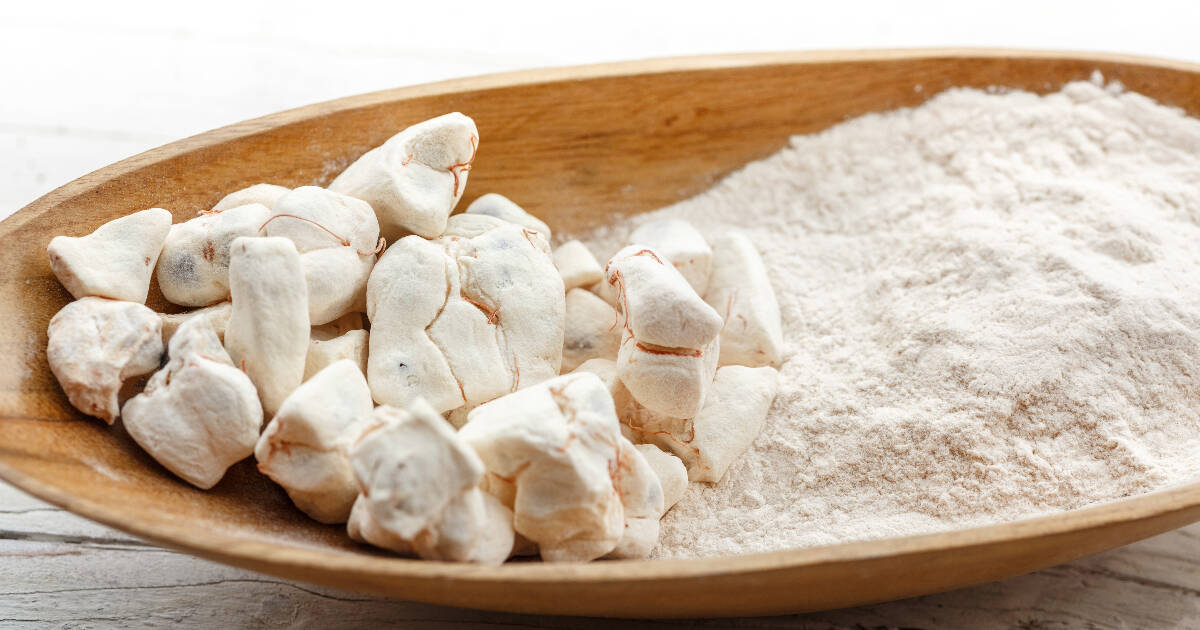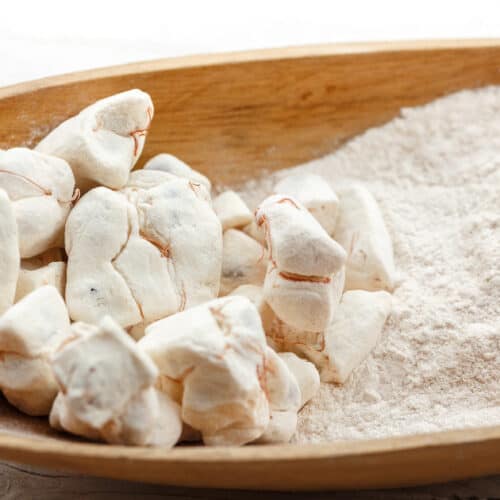The baobab is an impressive tree that grows in Africa, Australia, and other tropical regions. It's sometimes called the "tree of life" thanks to its many nourishing properties.

The baobab fruit and powder made from it contains high amounts of vitamin C, antioxidants, fibers and other beneficial nutrients.
What is Baobab Powder and Why Make it at Home?
Baobab powder is created by splitting open the hard shells of baobab fruit and milling the white pulp inside into a fine powder. This mildly sweet and tangy powder can then be used as a nutrient-dense addition to smoothies, baked goods, snacks and more.
Making your own homemade baobab powder is often cheaper than buying pre-made powder. It also ensures you get an extra-fresh product. By making it yourself, you can also customize the texture and have fun experimenting with recipes.
Key Takeaway: Baobab powder is made by milling the dried pulp of the baobab fruit. Making homemade powder allows you to save money and control quality.
Health and Nutrition Benefits of Baobab Powder
Baobab powder is prized for its rich nutritional profile. Here are some of the key health benefits it provides:
- Exceptionally high in vitamin C - Contains over 10 times more vitamin C than oranges per serving! This nutrient is important for immunity, skin health, iron absorption and tissue repair.
- Antioxidant powerhouse - Packed with antioxidant compounds like polyphenols that help neutralize disease-causing free radicals.
- High fiber content - Each serving delivers considerable amounts of dietary fiber to support digestion and heart health.
- Supports hydration - Has an ability to rehydrate the body quickly due to its absorptive nature. Useful for athletes and after illness.
- Supports weight loss - The fiber can promote feelings of fullness and improved fat metabolism.
- May lower blood sugar - Early research shows it can help decrease blood sugar spikes after meals.
So by making your own powder, you can reap all these benefits in an affordable and natural way. It's no wonder baobab is considered a true superfood!
How to Make DIY Baobab Powder

Homemade Baobab Powder Recipe
Ingredients
- Fresh baobab fruit
- Dehydrator (optional)
- Food processor, high speed blender or coffee grinder
- Fine mesh sieve
- Glass jar for storage
Instructions
- Obtain fresh pods - Harvest fresh baobab pods when possible. If using store-bought, opt for raw dried pods.
- Crack open pods - Break open pods and separate the white pulp from shells and fibers. Fresh pods will naturally crack open when dry.
- Dehydrate pulp (optional) - Place separated pulp on mesh dehydrator sheets and dehydrate 6-12 hours until completely dry. Drying helps pulverize into powder. Skip if using pre-dried pulp.
- Process into powder - Add dry pulp to your blender, food processor, or coffee grinder. Blend on high until a fine powder consistency is reached. May take a few minutes to get powder as smooth as possible.
- Sift powder - Sift powder through a mesh strainer into a glass jar to remove any chunks. Add any remaining bits back into blender and re-blend into powder again.
- Store - Keep powder in sealed glass jar in a cool dry place like the fridge or pantry. Will stay fresh up to one year when stored properly.
And that's it - a super simple way to end up with homemade baobab powder! Be creative with adding it to foods and drinks.
Tip: If the powder clumps, simply stir the dry powder into a bit of hot water until dissolved before adding to recipes.
Recipes Using Baobab Powder
Your homemade baobab powder opens up many possibilities to use this nutrient-dense ingredient for culinary and health benefit. Here are some ideas:
Smoothies
Stir 1 tsp - 1 tbsp baobab powder into any smoothie recipe for an immune and digestion boost. It pairs especially well with tropical fruits like mango and pineapple.
Oatmeal
Add a spoonful into your morning oatmeal along with fruit, nuts and milk of choice. It adds a slight tangy sweetness to balance the porridge.
Salad Dressings and Sauces
Whisk in a teaspoon or two into any vinaigrette, sauce or dip that calls for lemon juice. It provides a similar tangy flavor while ramping up the nutrition.
Overnight Oats
When making overnight oats, add 1-2 tsp powder while layering ingredients for a vitamin C and fiber boost. Its mild flavor won't overpower other mix-ins.
Yogurt and Chia Puddings
Stir in 1-2 teaspoons of powder into yogurt, chia seeds or non-dairy yogurt alternatives like coconut or almond yogurt before chilling to infuse some extra nutrients.
Baked Goods
Add a tablespoon into cookie dough, protein bars, granola bars or muffins to naturally sweeten while also lowering glycemic index.
DIY Skincare Masks
Mix powder into any face or hair mask recipe to amplify collagen production thanks to the abundance of antioxidant vitamin C.
Have fun trying it in your favorite recipes! The light tart, sweet and creamy flavor pairs well with so many ingredients.
| Food | Amount of Baobab Powder |
|---|---|
| Smoothies | 1 tsp - 1 tbsp |
| Oatmeal | 1-2 tsp |
| Salad Dressings | 1-2 tsp |
| Overnight Oats | 1-2 tsp |
| Yogurt | 1-2 tsp |
| Baked Goods | 1 tbsp |
| DIY Skincare Masks | 1+ tsp |
Making the Most of Your Homemade Baobab Powder
Here are some final tips for getting the most out of your homemade baobab powder:
- Mind storage - Keep powder in sealed glass jar in a cool, dark place like the fridge to optimize freshness and nutrient retention.
- Use quickly - Try to use up powder within 3-6 months for greatest quality and flavor. Vitamin C content diminishes over time with exposure to air, light and heat.
- Blend into liquids - For best dissolving results, first stir powder into a small amount of hot water, non-dairy milk or juice before adding to recipes.
- Enhance absorption - Using powder in recipes also containing foods high in vitamin C, iron and fat will maximize nutrient absorption by your body. Think citrus fruits, dark leafy greens, avocados.
- Adapt recipes - Start with small amounts of powder in recipes and adjust to taste preferences. Its tangy flavor can generally exchange for lemon juice in equivalents.
- Try skin and hair masks - Take advantage of the vitamin C content by adding powder to masks not just for ingesting but also applying topically for beauty benefits.
So go ahead - make your own super-nutritious baobab powder and unleash its many benefits through fun and tasty recipes!
FAQs
What does homemade baobab powder taste like?
Homemade baobab powder has a pleasant mild tart and lightly sweet flavor, generally described as tasting like sherbet, citrus fruits or apricots. It's not overly sweet which makes it versatile for both savory and sweet recipes.
Can you use fresh baobab pulp?
While fresh baobab pulp can be consumed immediately for its vitamin C content, it needs to be dried out completely before attempting to turn it into powder. Removing all moisture ensures it blends properly into a fine powder rather than clumping.
How long does homemade baobab powder last?
When stored properly in an airtight container in a cool, dark place, homemade baobab powder will stay fresh for 6 months up to 1 year before nutrients like vitamin C start to diminish. Keeping it refrigerated helps lengthen its shelf life.
What is the best way to use baobab powder?
Baobab powder is versatile to use in both foods and skin/hair DIY treatments. For ingesting, it's excellent added to smoothies, oatmeal, salad dressings, sauces, baking and more. For topical use, blend into any beauty mask recipe to take advantage of its hydrating and rejuvenating vitamin C. Start with small amounts and adjust recipe quantities to your taste and purpose.
Conclusion
Making nutrient-packed baobab powder right at home is simple, affordable and rewarding.
With just a few basic steps, you can have a tasty superfood ingredient ready to boost countless recipes with vitamins, minerals, antioxidants and fiber for both health and beauty benefits.

